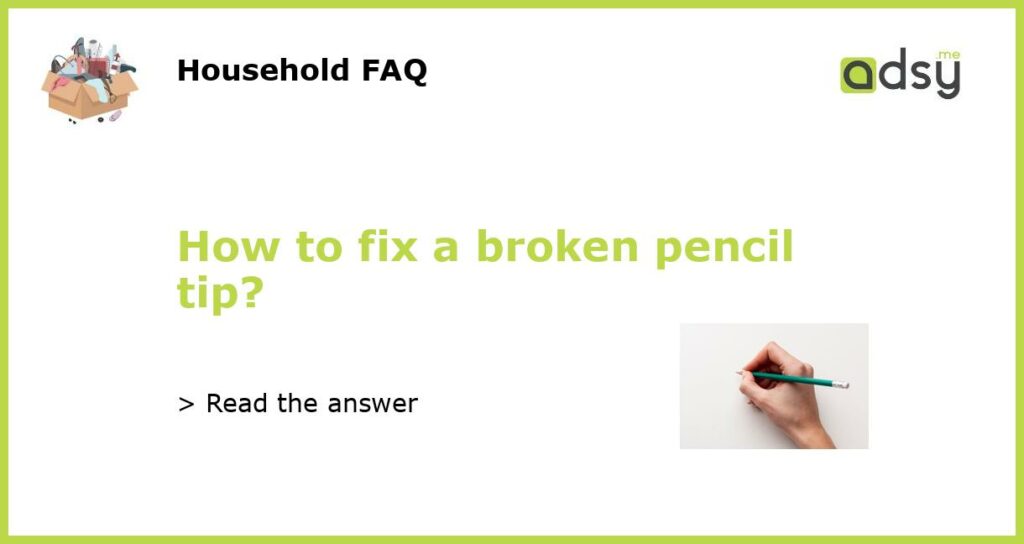Understanding the Issue: The Anatomy of a Broken Pencil Tip
A broken pencil tip can be frustrating, especially if you are in the middle of an important task or assignment. It can hinder your writing or drawing abilities, and in some cases, even render the pencil unusable. Understanding the anatomy of a broken pencil tip is crucial in finding the best solution to fix it.
When a pencil tip breaks, it typically results in a sharp, uneven edge that can make writing or drawing difficult. The break can occur at different points along the tip, ranging from a minor chip to a more significant fracture. The severity of the break will determine the approach you need to take in fixing it.
Tools and Materials You’ll Need
Before attempting to fix a broken pencil tip, gather the necessary tools and materials. This will ensure that you have everything you need to achieve the best results.
Here’s a list of items you’ll need:
- Sharp knife or blade
- Pencil sharpener
- Sandpaper or emery board
- Super glue or epoxy adhesive
- Optional: small piece of tape or rubber band
Step-by-Step Guide to Fixing a Broken Pencil Tip
Now that you have your tools ready, follow these step-by-step instructions to fix a broken pencil tip:
Step 1: Assess the break – Examine the broken tip of the pencil to determine the extent of the damage. If the break is minor, you may only need to sharpen the pencil to restore its usability. For more severe breaks, continue with the following steps.
Step 2: Trim the broken tip – Use a sharp knife or blade to trim away any jagged or splintered edges of the broken tip. Be careful not to remove too much, as you still want the pencil to have a functional length.
Step 3: Sharpen the pencil – With the trimmed tip, insert it into a pencil sharpener and twist it slowly to generate a new, sharp point. Take your time to ensure the tip is evenly shaped and free of any rough spots.
Step 4: Smooth the tip – If the sharpened tip still feels rough or uneven, lightly sand it with sandpaper or an emery board. This will create a smoother surface for writing or drawing.
Step 5: Secure the tip (optional) – If you want added reinforcement, apply a small amount of super glue or epoxy adhesive to the broken area. Be careful not to use too much adhesive, as it may affect the pencil’s ability to be sharpened in the future. You can also wrap a small piece of tape or use a rubber band around the tip for temporary stabilization.
Preventing Future Breaks
Avoiding future breaks can help maximize the lifespan of your pencil and prevent further frustrations. Here are a few tips to keep in mind:
1. Handle with care – When using a pencil, try to avoid applying excessive pressure or bending it, as this can lead to breakage.
2. Sharpen properly – Use a high-quality pencil sharpener that is appropriate for the pencil’s diameter. Avoid forcing the pencil into the sharpener, as this can cause the tip to break.
3. Use the right pressure – Different writing or drawing techniques require varying levels of pressure. Experiment with different pressures to find what works best for you while minimizing the risk of breakage.
4. Optimize storage – Store your pencils in a protective case or pencil holder to prevent them from rolling off surfaces and potentially breaking.
When to Replace a Pencil
While broken pencil tips can often be fixed, there are instances where it may be necessary to replace the pencil altogether. Consider replacing your pencil if:
1. The break is too severe to fix, making it impossible to sharpen or use the pencil effectively.
2. The pencil is heavily used and worn down, resulting in constant breakage or a significantly shortened usable length.
3. You find yourself continually fixing the pencil tip, indicating a potential flaw in the pencil’s structure.
Remember, pencils are inexpensive and widely available, so don’t hesitate to invest in a new one if needed.






